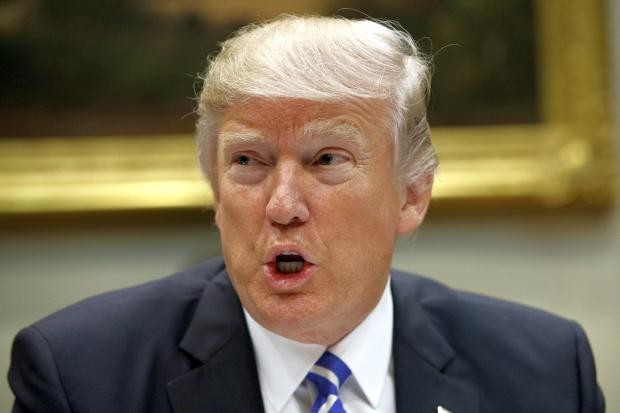
In this photo, taken on March 1, 2017, President Donald Trump speaks in the Roosevelt Room of the White House in Washington. President Trump’s revised travel ban will temporarily halt entry to the US for people from six Muslim-majority nations who are seeking new visas, allowing those with current visas to travel freely, according to a fact sheet obtained by The Associated Press. (Photo by EVAN VUCCI/AP)
WASHINGTON — President Donald Trump on Monday signed a reworked version of his controversial travel ban Monday, aiming to withstand court challenges while still barring new visas for citizens from six Muslim-majority countries and temporarily shutting down America’s refugee program.
The revised travel order leaves Iraq off the list of banned countries but still affects would-be visitors and immigrants from Iran, Syria, Somalia, Sudan, Yemen and Libya.
Trump privately signed the new order Monday while Homeland Security Secretary John Kelly, Secretary of State Rex Tillerson and Attorney General Jeff Sessions formally unveiled the new edict. They did not take questions from reporters.
The low-key rollout was in contrast to the first version of the order, which Trump signed a week after his inauguration in a high-profile ceremony at the Pentagon’s Hall of Heroes as Secretary of Defense James Mattis stood by.
In addition, White House Press Secretary Sean Spicer was not scheduled to hold an on-camera briefing Monday, leading to the appearance that the president was distancing himself from the order, which was a signature issue during his campaign and the first days of his presidency. The order also risks being overshadowed by unsubstantiated accusations Trump made over the weekend that former President Barack Obama had ordered the wiretapping of his phone during the campaign.
Trump officials say that even with the changes, the goal of the new order hasn’t changed: keeping would-be terrorists out of the United States while the government reviews the vetting system for refugees and visa applicants from certain parts of the world.
Tillerson described the new order Monday morning as “a vital measure for strengthening our national security.”
The original travel ban caused chaos at airports around the country as Homeland Security officials scrambled to interpret how it was to be implemented and travelers were detained before being sent back overseas or blocked from getting on airplanes abroad. The order quickly became the subject of several legal challenges and was put on hold last month by a federal judge in Washington state. The original order was rescinded Monday.
Kelly said Congress and others have been briefed about the order, which won’t take effect until March 16, and there should be no surprises. He called the effort “prospective” and reiterated that it applies only to refugees who aren’t already on their way to the United States and people seeking new visas.
The White House dropped Iraq from the list of targeted countries following pressure from the Pentagon and State Department, which noted Iraq’s role in fighting the Islamic State group. An Iraqi spokesman said the change marks a “positive step” and shows the countries have a “real partnership.”
Syrians are also no longer subjected to an indefinite ban, despite Trump’s insistence as a candidate that Syrians posed a serious security threat.
Sessions said Monday that national security is the driving force behind the ban and pointed to the cases of 300 people he said entered the United States as refugees who are now being investigated by the FBI as part of terrorism-related cases. He provided no details.
A senior Justice Department official earlier in the day cited the same statistic to reporters in a background call. The official refused repeated requests to provide any details about those cases, including the nationalities of the 300, or to say how long they have been in the United States.
The new order does not address concerns raised in a Homeland Security intelligence analysis obtained last month by The Associated Press that concluded there was insufficient evidence that citizens of the originally banned countries posed a terror threat to the US. The administration has played down the significance of that report.
According to a fact sheet distributed by the administration, Homeland Security officials will do a country-by-country review of the information that nations provide to the US for visa and immigration decisions. Those countries will then have 50 days to comply with US requests to update or improve that information.
The suspension of the refugee program is for 120 days, though refugees already formally scheduled for travel by the State Department will be allowed entry. When the suspension is lifted, the number of refugees allowed into the US will be capped at 50,000 for the fiscal year ending Sept. 30.
The new version also removes language that would give priority to religious minorities. Critics had accused the administration of adding such language to help Christians get into the US while excluding Muslims.
“I think people will see six or seven major points about this executive order that do clarify who was covered,” said presidential counselor Kellyanne Conway in an interview with Fox News Channel’s “Fox & Friends.”
Legal experts say the new order addresses some of the constitutional concerns raised by a federal appeals court about the initial ban, but leaves room for more legal challenges.
“It’s much clearer about how it doesn’t apply to groups of immigrants with more clearly established constitutional rights,” said University of Texas law professor Stephen Vladeck. “That’s a really important step.”
Removing language that would give priority to religious minorities helps address concerns that the initial ban was discriminatory, but its continued focus on Muslim-majority countries leaves the appearance that the order is a “Muslim ban,” Vladeck said.
“There’s still going to be plenty of work for the courts to do,” he said. –Alicia A. Caldwell and Jill Colvin
* * *
Associated Press reporters Julie Pace and Sadie Gurman contributed to this report.